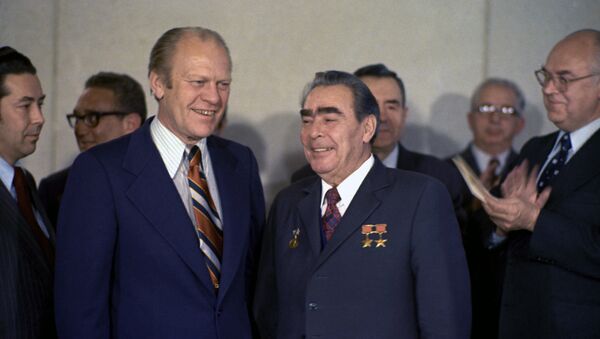MOSCOW, November 23 (Sputnik) — On November 23-24, 1974 Leonid Brezhnev, General Secretary of the Central Committee of the Communist Party of the Soviet Union, and US President Gerald Ford held talks in then-Soviet far eastern city of Vladivostok, paving the way for future groundbreaking agreements on nuclear arms control between the two superpowers.
By the 1970s, the arms race reached a critical point. The leaders of the world powers realized that only the Soviet Union and the United States could stop the process. Preparations for the next stage of negotiations on the limitation of strategic weapons had been ongoing for two years.
It was not by chance that Vladivostok was chosen as a venue for signing the Treaty. The city hosting the base of the powerful Soviet Pacific Fleet and a number of defense enterprises had been closed for foreigners for 30 years. Vladivostok was a place of interest for people from all over the world. The arrival of the US President accompanied by dozens of officials and journalists would prove the Soviet government’s desire to ease the international situation and show trust in its partner. This was the decisive factor in determining the venue and the unofficial program of the negotiations.
The two nations’ leaders arrived at the Vozdvizhenka military airport outside Ussuriysk. Leonid Brezhnev was travelling on an Ilyushin Il-62 (Classic) and Gerald Ford arrived on a Boeing-707. The number of participants of the meeting totaled 120, about 60 on each side. The main part of the summit was held at a military health and recreation facility near the Sanatornaya railway station, where Brezhnev and Ford were taken from the airport by train. The Soviet leader and the US President decided to start the talks right in the train car. The negotiations lasted all day. Around 70 reporters from the world’s major media outlets and some 40 Soviet journalists were covering the summit.
A joint Soviet-US declaration was signed during the meeting whereby the parties confirmed their willingness to conclude a new strategic arms limitation treaty (SALT) by the end of 1985.
Based on the principle of equality and equal security, the new agreement was to include a number of significant limitations. In particular, the parties had agreed on an equal limit of 2,400 ballistic missiles and strategic bombers.
In addition, both signatories were entitled to the deployment of up to 1,320 multiple independently targetable reentry vehicles. Legal details, the wording, and the signing of the new treaty were expected to be completed by the end of 1975. Negotiations on further limitation of strategic armaments for the period beyond 1985 were scheduled to be resumed no later than in 1980-1981.
The Vladivostok agreement was a major step in curbing the arms race. It set clear and equal long-term limits of nuclear weapons vehicles for the Soviet Union and the United States, and for the first time ever included long-range bomber aviation. Also, limits were set for the first time on the deployment of multiple independently targetable reentry vehicles, which marked the first step on limiting the qualitative arms race.

